#milkweed longhorn beetle
Explore tagged Tumblr posts
Text


@lhinelle submitted: Hi! what kind of friend is eating my milkweed in Minneapolis MN? Thanks so much!
Hello! This is a red milkweed beetle, Tetraopes tetrophthalmus. Very common on milkweed!
#animals#insects#bugs#submission#beetle#longhorn beetle#milkweed longhorn beetle#red milkweed beetle
102 notes
·
View notes
Text



Red milkweed beetle (Tetraopes tetrophthalmus) Pennsylvania, US
The genus name means "four eyes" since the antennae actually bisect each eye (probably best seen in the second picture). As their common name implies, these beetles eat milkweed, and their bright colors warn that they contain toxins from their host plant.
#Tetraopes tetrophthalmus#milkweed beetle#longhorn beetle#beetle#coleoptera#Cerambycidae#four eyes#bugs#nature#nature photography#biodiversity#bugblr#animals#arthropods#inaturalist#entomology#insect appreciation#creature#red#milkweed#critters#pennsylvania#biology#invertblr#invertebrates
63 notes
·
View notes
Text





Red Milkweed Beetles (Tetraopes tetrophthalmus), family Cerambycidae, on Common Milkweed, Anna Arbor, MI, USA
photographs by Paxon Kale CC
#milkweed beetle#longhorn beetle#tetraopes#cerambycidae#beetle#coleoptera#insect#entomology#animals#nature#north america
98 notes
·
View notes
Text










Milkweed Beetle - Tetraopes tetrophthalmus
This week in Toronto: the weather brought a long heat wave with little reprieve, which came in the form of some heavy rain and occasional thunder. Both conditions made bug hunting a bit tedious, but there were moments where going outside to photograph without the phone overheating was possible. As a result, we have today's post: the first Red Milkweed Longhorn Beetle of the season! At least, it's the first one found in the open among front yard milkweed stalks (which are to monitored for Milkweed Stem Weevils). It was hot for me and surely it was also hot for this insect. This individual was likely out and about as a bit of cloud cover blocked the sun for a short while. Quite frankly, it's the reason I was outside too. Although crawling on milkweed and taking bites from the toxic leaves and growing buds is a necessity, when weather becomes too intense these Beetles could be at risk of desiccation. Eating plants may help this slow the loss of water (by consuming it), but for this weather more drastic actions need to be taken.
Thanks to their small size, insects can make the most of shaded areas, whether by falling to the soil below, hanging on a branch's underside, or hiding underneath a large milkweed leaf (or the leaf beneath that one). Even a slight change in elevation can have a substantial difference in the way temperature is felt by these insects. Its much the same way that shade makes the difference for us on a hot day. While milkweed is their home, the Beetles in my yard also like crawling on the pine bushes, but do not feed on them. They instead use the pine bushes to reach new milkweed leaves and stalks that would only be accessible by flight. Given that insect flight can generate tremendous heat, it may have been too hot to fly. Even insects are capable of overheating, and they need to know their limits in order to survive. As such, after holding the Beetle in my hand, I placed it back on the milkweed where I found it, no flight required. What a magnificent specimen with such bright colors! I hope to see find many more this year. Maybe this time I'll be able to hear one of them purr, or even squeak (which was observed recently in a more mottled-colored Longhorn find).
Pictures were taken on June 17, 2024. Happy First day of Summer! Stay cool.

#jonny’s insect catalogue#ontario insect#beetle#milkweed beetle#longhorn beetle#coleoptera#insect#toronto#june2024#2024#first day of summer#nature#entomology#invertebrates#arthropods#photography#animals
34 notes
·
View notes
Text
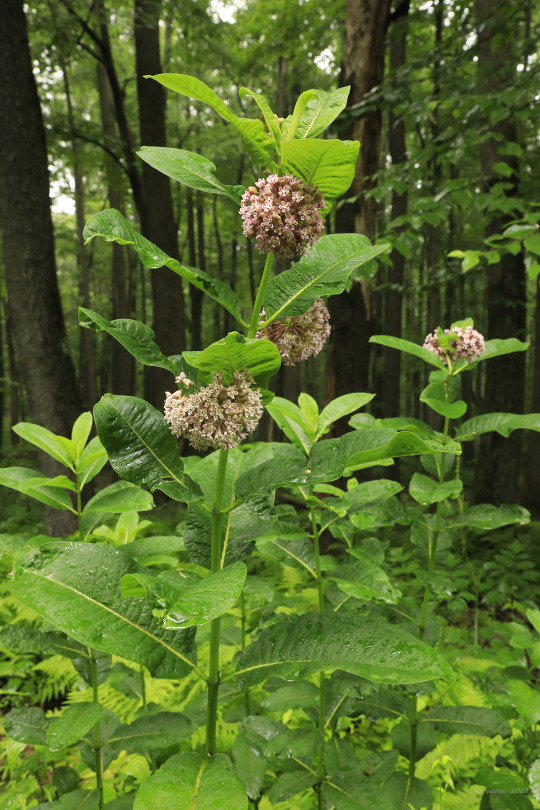

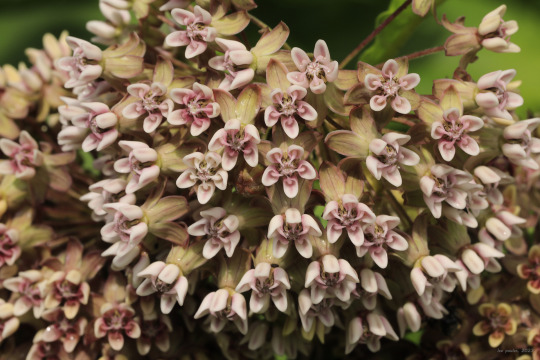

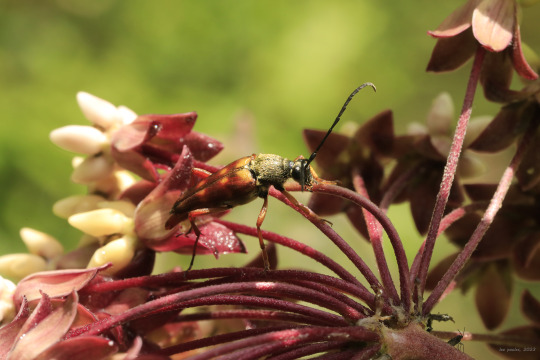
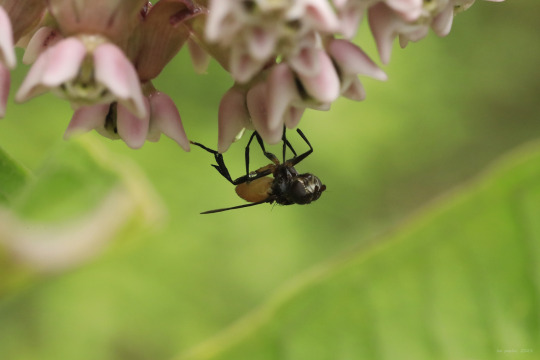

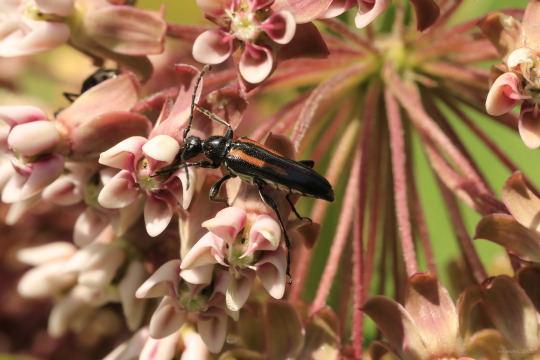
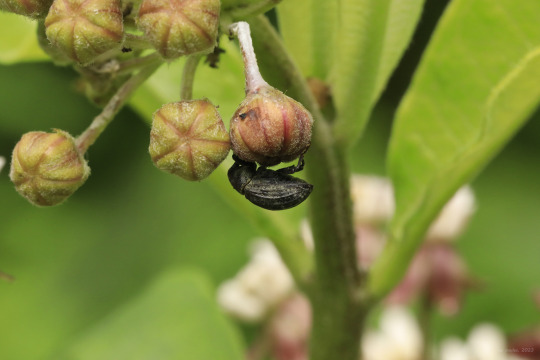
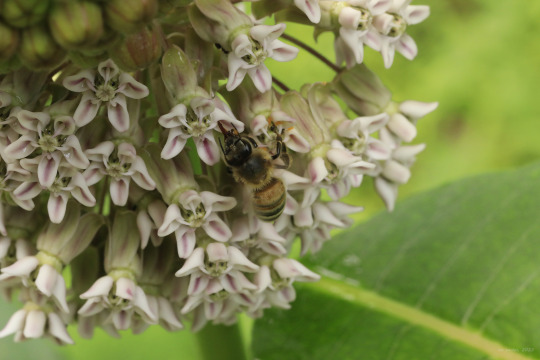
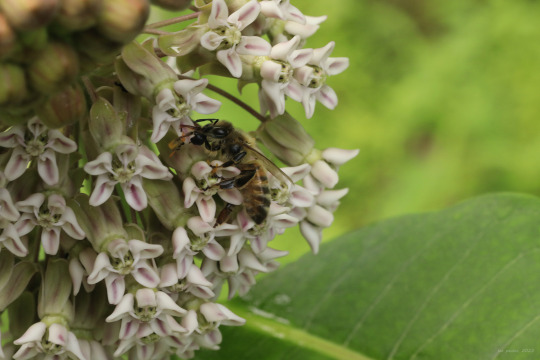
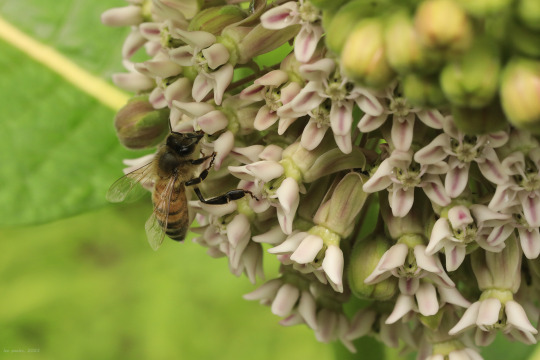
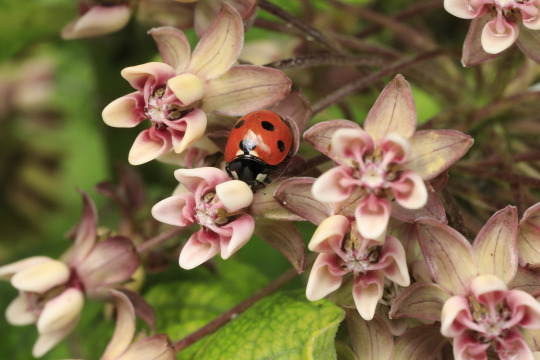
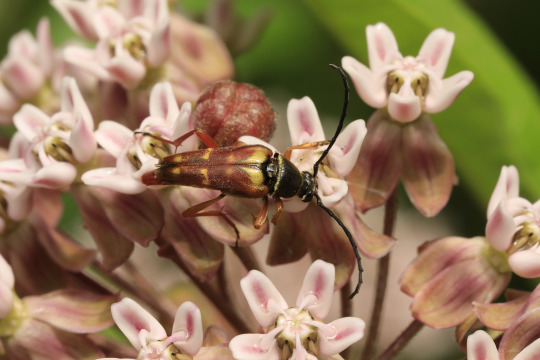
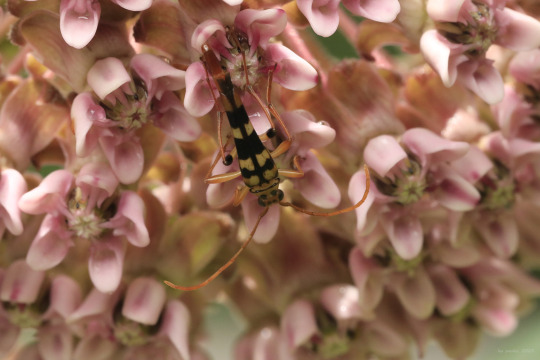
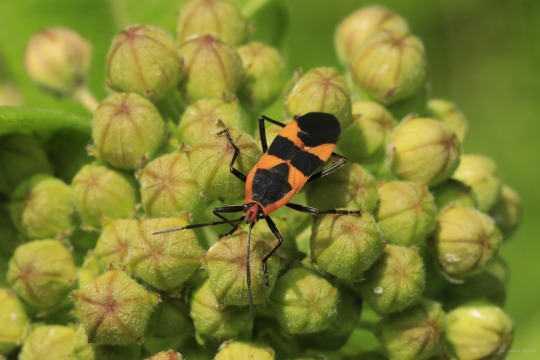
“In planning to be a professional naturalist….. I turned to the teeming small creatures that can be held between the thumb and forefinger, the little things that compose the foundations of our ecosystems, the little things that I like to say, run the world.”
Edward O. Wilson
By observing a milkweed plant very closely for more no more than five minutes, you will begin to understand exactly what Wilson was getting at.

#wildflowers#flora#appalachia#vandalia#west virginia#coopers rock state forest#summer#common milkweed#life#diversity#biodiversity#ecology#insects#the little things#life is beautiful#life is fragile#large milkweed bug#longhorn beetle#honeybee#milkweed weevil#seven-spotted ladybug#net-winged beetle#edward o. wilson#e. o. wilson
201 notes
·
View notes
Text

Another carousel bug pin design, a milkweed beetle
17 notes
·
View notes
Text


#mine#photo#green#nature#plants#insects#meadow#cute little beetle in the first one!! i think a milkweed longhorn?
3 notes
·
View notes
Text



Bugs loving the native plant area along the sidewalk!
#false milkweed bug#monarch butterfly#milkweed longhorned beetle#native plants#bugs#insects#entomophagy#native plant garden#milkweed
0 notes
Text
today’s best bug encounter was this Prionus laticollis. a large longhorn beetle that feeds on dead tree roots, they are one of the largest commonly encountered beetles around here.
some impressive shearing jaws on this lady
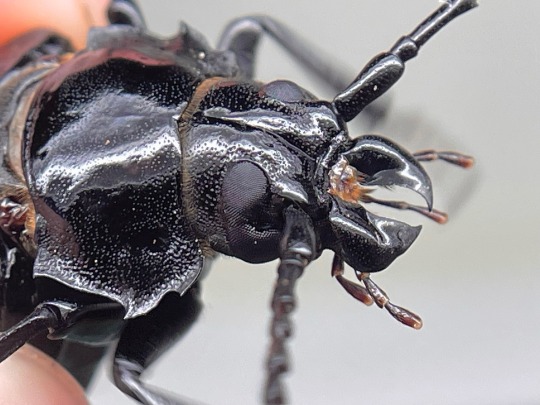
my favorite cerambycid trait is their wraparound eyes, which curve from the top of their head around the base of the antenna to the bottom surface of the head.
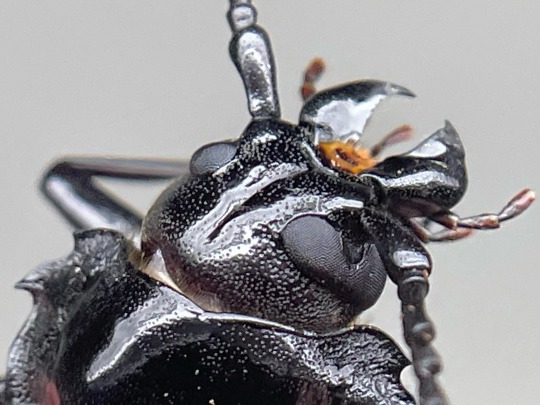
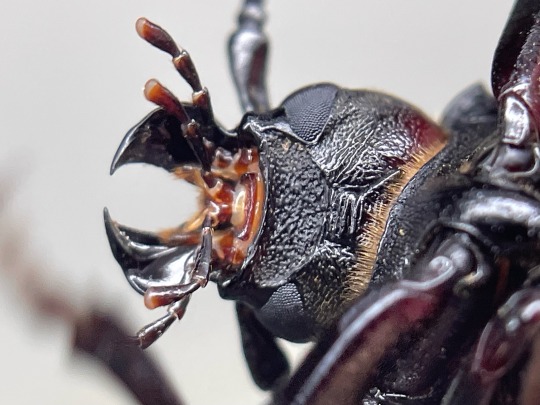
next time I’m in the milkweed field I’ll try to find another commonly spotted longhorn with even stranger eyes!
2K notes
·
View notes
Note
sunnycotton has got me thinking about the "asking someone out with an insect" fallenclan tradition, and so i've decided to compile a little list of what insects i think have been used in the past... there are so many cool insects i WANTED to add but i'm going to try and be at least. semi-realistic. about what types of insects these mountain cats could plausibly have found.
antbite/lionsong = asian longhorned beetle
moorthistle/littleleaf = monarch butterfly caterpillar (specifically a caterpillar because of its soft texture - neither of them killed it. moor gave it to little for him to inspect and once he realized what she meant he instantly accepted. she later returned the caterpillar to the milkweed plant it had been on)
russetflare/cinderstone = eastern-eyed click beetle (russet was SO proud of catching one, cinder was reluctantly impressed)
willowsplash/bub = boll weevil
blizzardfang/crowflame = pill bug (roly-poly)
nettlestem/scorchstar = indigo duskywing skipper butterfly
newtscar/bluefern = spotted orbweaver (BEFORE evie joined the polycule)
newtscar/bluefern/evie = silver arigiope (after learning of the tradition, evie found one of these guys for his wives)
goldenstar/morningbloom = yellow garden spider
beefreckle/jaycall = praying mantis
cloudtuft/pondshine = green lynx spider (pond was like "cool thx!" at first and then cloud had to explain the tradition)
mossfrog/rustbee = green lacewing
ashblink/sleepydawn = checkered skipper butterfly
sleepycloud/ivybounce = two-striped grasshopper
yewberry/brambletuft = common scorpionfly
flyspots/wormshade = the spongy moth (wormshade didn't know about the tradition, being the kit of an ex-kittypet, and reluctantly accepted, confused. hence why flyspots thought they were mates)
pebblefreeze/human = brown centipede (these two aren't mates, and i see them as more of a QPR situation, but i feel like pebble would've given human a brown centipede anyway. he was horrified)
-🐉(i am in no way an insect expert, esp in regards to location so these still might be wildly impossbile. that's ok tho, fallenclan can exist in a pocket dimension with all the insects)
CUTE!!!!!!!!! all around very good choices (canonizing littlemoor monarch caterpillar & blizzardcrow pill bug bc AUGHHHH <3), i love the way your mind works... also pebble giving human a centipede really makes me giggle
also a few of these do have canon bugs here!
68 notes
·
View notes
Text


milkweed beetle (Tetraopes sp.)
correction now that i've finally taken the time to look more closely at this guy, it's actually a milkweed beetle lookalike in a completely different subfamily, Tylosis maculatus. you can tell by comparing its face to that of an actual milkweed beetle, notably the much larger eyes not bisected by the antennae. also it's not apparent in these photos but milkweed beetles like all other species in the Lamiinae subfamily ("flat-faced longhorn beetles") have the last segments of their palps tapered, while with a couple very minor exceptions all other longhorns have them dilated

72 notes
·
View notes
Text







@goldfishaquarium submitted: Wanted to share a bug from my garden, but turns out I have too many photos of bugs. Here's a lil photo dump collection
I'd say this is just the right amount of photos of bugs! They're all great but the pretty crab spider is my fav. Also RIP to the bee that robber fly is eating..
#animals#insects#bugs#spider#arachnids#submission#robber fly#bug death#predation#crab spider#beetle#sweat bee#bee#milkweed longhorn beetle
113 notes
·
View notes
Note
🛸or🧩
🧩: favorite niche technique from one of your hobbies
does anyone else know how to chop vegetables against your left thumb/fingers instead of on a cutting board or is this something only my mom taught me
🛸: favorite bug
MILKWEED LONGHORN BEETLE……..
4 notes
·
View notes
Text
milkweed longhorn beetles are so funny. with their eyes like that.
0 notes
Text










Milkweed Beetle - Tetraopes tetrophthalmus
They're back, just as always! As summer rolls on, these red Longhorn Beetles emerge from the soil and begin claiming milkweed stalks for food and territory. To me, many of the individuals I've seen are smaller than usual, but without measuring them I can't verify that they are getting smaller. For all I know, I'm just finding a lot of males. They've been rather abundant this year, and continue to be found in the garden even now in August. They enjoy the warmth as they feed on the leaves, buds and flowers of their milkweed homes. Much of chewed leaves seen here are the result of these 4-eyed friends. When the sun becomes too much for them, they can retreat to shady spots underneath the milkweed leaves or pull against the stalk. Sometimes that involves a quick scamper and other times (such as if they feel threatened) they'll just tuck in and fall below, just like the individual in Picture 5. Tucking and falling is a good method to suddenly escape if there's not enough time (or room) to fly, but it's quite risky to land on your shell if you're a Beetle. After a short while, the individual who fell perked up and resumed its patrol of the milkweed leaves.
As mentioned in earlier posts, if territory can be secured for these Beetles and they stay healthy and well-fed, successful mating pairs can form. There are always many this year in the garden, and it's likely that these Beetles' lineages now span many generations. Seeing Beetles on the milkweed stalks of my neighbors and the surrounding wilderness and wildflowers made me wonder this time if other Beetles are flying in from those areas to use this area as their home after emerging from their pupa. A Milkweed Beetle exchange program if you will. Without ample monitoring, tracking and observation I'll never know, but I am curious now. When these Beetles emerge, do they simply accept their area if milkweed is ample and healthy, or is there the temptation to leave and search for a new area? The latter is possible (especially if stalks are removed), but let's just hope the new adults are ready to location scout. As Pictures 2, 7 and 9 will show you, there are larger rival Beetles out there that drive smaller, less aggressive challengers away. However the circle of life turns and goes, it's always wonderful to find these Beetles year and year and to take for them by taking of our milkweed. Of course, healthy milkweed also means pollinators will arrive as well, like the Honeybee or Monarch Butterflies.
Pictures were taken on June 30 and July 4, 6, 9, 2023 with a Google Pixel 4.
#jonny’s insect catalogue#ontario insect#beetle#milkweed beetle#coleoptera#longhorn beetle#insect#milkweed#toronto#2023#june2023#july2023#nature#entomology#mating pair#invertebrates#arthropods#animals#photography
5 notes
·
View notes
Text

August 3rd, 2020
Found a little guy <3
3 notes
·
View notes